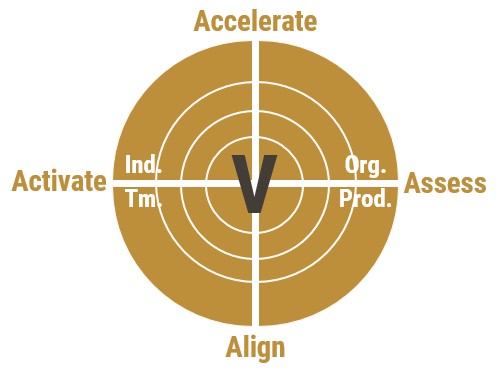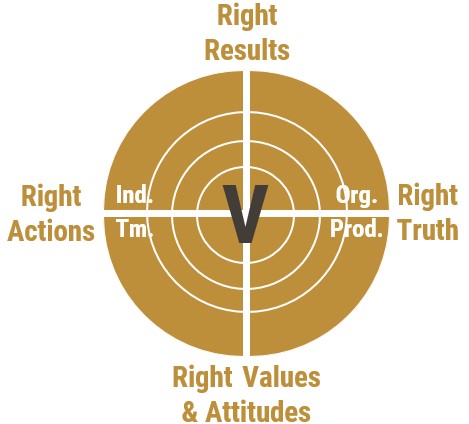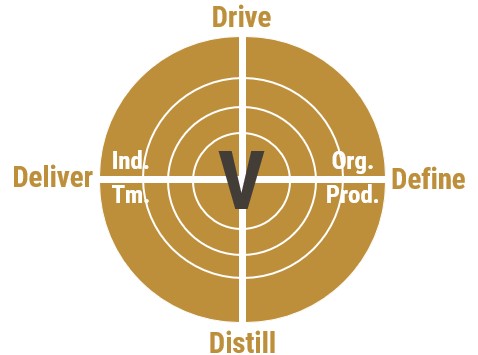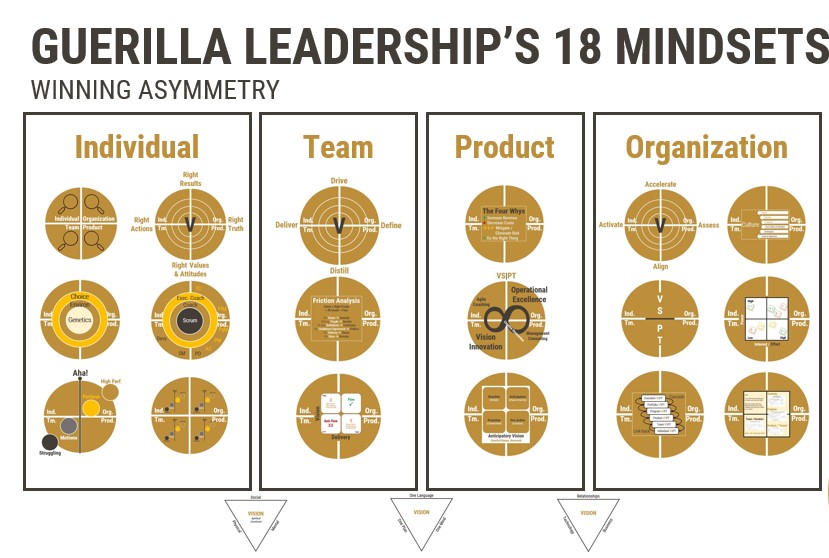The depth of wisdom hidden in ancient texts is often stunning. You can hear (or read) a story a hundred times and still miss subtle nuances that can only be seen (and understood) when revealed through other lenses. A Guerilla Leader views each situation through the lenses of asymmetry.
Even if you’re not a Christian, most everyone is familiar with the story of David and Goliath (it is recorded in 1 Samuel 17 in the Bible). And it has even entered our vocabulary as a metaphor for being an underdog.
It doesn’t matter whether you believe the account, or not, the ancient wisdom that is shared in it is as viable and relevant today as it was 3,000 years ago. Malcolm Gladwell’s book “David and Goliath: Underdogs, Misfits, and the Art of Battling Giants” dives into this story with some fascinating twists. You can see Malcolm’s Ted Talk on this topic here.
In this post we are going to explore the asymmetries and how David leveraged those to his advantage – and won! We will be integrating VSPT, Cascading Vision, the Flow Formula (Vision + Right People + 4D Model = Flow), the 4R Model, and the 4A Model throughout this post.
A high-level, 10 minute and 50 second summary is here on my Youtube channel:
Two Armies – A Tale of Two Visions (see Asymmetry #1 below)
- “Now the Philistines gathered their forces for war and assembled at Sokoh in Judah. They pitched camp at Ephes Dammim, between Sokoh and Azekah. Saul and the Israelites assembled and camped in the Valley of Elah and drew up their battle line to meet the Philistines. The Philistines occupied one hill and the Israelites another, with the valley between them.”
So, you have two armies in a deadlock. Neither will attack the other due to the terrain since neither side was willing to sacrifice the high ground (Sun Tzu most likely borrowed this tactic from this battle, or other ancient battles, since this one occurred over 1,000 years before he arrived on the scene).
Both sides had competing Visions for how to win the battle, similar Strategies (hold the high ground), armies of People with similar training, skills, and experience; and everyone had the same Task – to win. Mindset #14 in Guerilla Leadership is VSPT – where the black line represents the disconnect (and asymmetry) between the Vision & Strategy(s) and the People & Task(s):

Send in the Giant (Right People? see Asymmetry #1 below)
- “A champion named Goliath, who was from Gath, came out of the Philistine camp. His height was six cubits and a span. He had a bronze helmet on his head and wore a coat of scale armor of bronze weighing five thousand shekels; on his legs he wore bronze greaves, and a bronze javelin was slung on his back. His spear shaft was like a weaver’s rod, and its iron point weighed six hundred shekels. His shield bearer went ahead of him.”
As Malcolm Gladwell observed, why did the shield bearer go in front of Goliath? To lead the way down to the battlefield? Conventional wisdom is that is because Goliath needed to carry his spear and sword. Later we will get a hint at the extent of Goliath’s problems with his eyes and vision (not unusual for someone with either gigantism or acromegaly). So, he needed to be shown where to stand to fight his opponent (talk about clunky logistics!). As Malcolm also pointed out, Goliath was weighed down with over one hundred pounds of bronze armor thus rendering him almost immobile, so he was not agile by any stretch of the imagination.
And what about the shield bearer? He only had one job and that was to stop all incoming spears, arrows, etc. On this fateful day, he was an epic failure. Agilists love to use the acronym for “fail” as First Attempt In Learning. That’s a cute soundbite, but for Goliath, this was his first and last attempt.
Sometimes failure is fatal.
Trusting Tesla’s autopilot and then plowing into the back end of a tractor trailer would be a good example of that. Yes, learning occurred, but that was irrelevant for the passengers in the car since what they experienced was catastrophic and permanent.
Psychological warfare – communicating your vision for change (see Asymmetry #1 below)
- “Goliath stood and shouted to the ranks of Israel, “Why do you come out and line up for battle? Am I not a Philistine, and are you not the servants of Saul? Choose a man and have him come down to me. If he is able to fight and kill me, we will become your subjects; but if I overcome him and kill him, you will become our subjects and serve us.” Then the Philistine said, “This day I defy the armies of Israel! Give me a man and let us fight each other.” On hearing the Philistine’s words, Saul and all the Israelites were dismayed and terrified.”
Goliath must have been a remarkable sight. He would have towered over everyone. Being afraid, dismayed, and terrified seems to block outside-the-box-thinking. So, no one took up the challenge since they couldn’t think of a way to beat Goliath in hand-to-hand combat. No one was big enough or strong enough to even dare to try that.
Meet the shepherd boy (see Asymmetry #3 below)
- “Now David was the son of an Ephrathite named Jesse, who was from Bethlehem in Judah. Jesse had eight sons, and in Saul’s time he was very old. Jesse’s three oldest sons had followed Saul to the war: The firstborn was Eliab; the second, Abinadab; and the third, Shammah. David was the youngest. The three oldest followed Saul, but David went back and forth from Saul to tend his father’s sheep at Bethlehem.”
David’s formative years were as a shepherd. This feels like a highly unlikely training ground for a future warrior king, doesn’t it?
Asymmetry # 1 – Persistently communicating your vision for change
- “For forty days the Philistine came forward every morning and evening and took his stand.”
There was no doubt in anyone’s mind as to what Goliath and the Philistines had as their vision. After 40 days, anyone on either side of the battle could have written it down, word-for-word, from memory.
Communicating Vision (Mindset #15 in Guerilla Leadership) effectively and efficiently requires that it must be short, memorable, and easy to communicate (i.e., Cascading – and that’s what Goliath did, persistently, for 40 days):

Without exception, most organizations miss the link-back to the next level up. We’ll see further down in this story that David somehow intuitively knew that if he persisted, the link-back would happen organically (Asymmetries #2, 3, and 4 below).
The shepherd boy sent to the front lines (see Asymmetry #3 below)
- Now Jesse said to his son David, “Take this ephah of roasted grain and these ten loaves of bread for your brothers and hurry to their camp. Take along these ten cheeses to the commander of their unit. See how your brothers are and bring back some assurance from them. They are with Saul and all the men of Israel in the Valley of Elah, fighting against the Philistines.”
- Early in the morning David left the flock in the care of a shepherd, loaded up and set out, as Jesse had directed. He reached the camp as the army was going out to its battle positions, shouting the war cry. Israel and the Philistines were drawing up their lines facing each other. David left his things with the keeper of supplies, ran to the battle lines and asked his brothers how they were. As he was talking with them, Goliath, the Philistine champion from Gath, stepped out from his lines and shouted his usual defiance, and David heard it. Whenever the Israelites saw the man, they all fled from him in great fear.
Goliath instilled fear, which is an acronym for “Forget Everything And Run.” And they didn’t just run, the “mighty-men-of-power-and-valor” fled the field of battle. Yes, it’s another cute soundbite, but in this case, it is spot on.
The giants you face daily can create uncontrolled fear resulting in paralyzing friction, confusion, higher costs, and underperformance.
Asymmetry # 2 – What’s in it for me and what’s your why? (Assessing the Situation)
- Now the Israelites had been saying, “Do you see how this man keeps coming out? He comes out to defy Israel. The king will give great wealth to the man who kills him. He will also give him his daughter in marriage and will exempt his family from taxes in Israel.”
- David asked the men standing near him, “What will be done for the man who kills this Philistine and removes this disgrace from Israel? Who is this uncircumcised Philistine that he should defy the armies of the living God?”
- They repeated to him what they had been saying and told him, “This is what will be done for the man who kills him.”
Wow. Talk about fast track to promotion? You would get to marry the boss’s daughter and be tax exempt, as well? Cool! Sign me up, right? Wrong!
There were no takers for the King’s offer! Why had no one stepped up to the task? We need to cut King Saul a little slack since he didn’t have access to Daniel Pink’s research on what really motivates people and that is autonomy, mastery, and purpose. In Asymmetry #6 below we will find out what David’s higher purpose really was.
What is also interesting is that David applied a leadership pattern that we’ve captured as Mindset #13 in Guerilla Leadership:

Upon his arrival, David Assessed the situation (the first “A” in this Mindset). Throughout the balance of this account, David uses the remaining parts of this pattern and Mindset.
Asymmetry # 3 – Who do you think you are (Right People)?
- “When Eliab, David’s oldest brother, heard him speaking with the men, he burned with anger at him and asked, “Why have you come down here? And with whom did you leave those few sheep in the wilderness? I know how conceited you are and how wicked your heart is; you came down only to watch the battle.””
Family hierarchies can be amazingly harmful when the older siblings are completely clueless about the skills, experience, and results that a younger sibling may already have delivered (as it was in this case). The oldest brother made a rash judgment about his youngest brother’s motives and tried to shame him, publicly, to get him to shut up.
Well, that tactic didn’t work.
Asymmetry # 4 – heard it through the grapevine
- ““Now what have I done?” said David. “Can’t I even speak?” He then turned away to someone else and brought up the same matter, and the men answered him as before. What David said was overheard and reported to Saul, and Saul sent for him. David said to Saul, “Let no one lose heart on account of this Philistine; your servant will go and fight him.””
Here’s a young man stepping up when all the other valiant warriors had stepped aside. Saul heard about David through the grapevine (via informal communications and link-back, as shared in Mindset #15, Cascading Vision). I can only imagine the half-amusement, half-confusion that Saul must have felt at that moment when he met David. If I could read Saul’s mind, he must have been thinking something like “seriously, is the smallest dude in the camp going to take on a giant that no one else dares to confront?”
Asymmetry # 5 – Lack of training, experience, and too young?
- “Saul replied, “You are not able to go out against this Philistine and fight him; you are only a young man, and he has been a warrior from his youth.””
Saul’s response is so typical. This is always the Catch-22 situation that young people face when trying to land that first role out there in the real world. Too young. Not enough experience. Need more training, etc.
On top of that, Saul misunderstood what constitutes a true warrior. As we’ll see in a minute, David had been training his entire life for this moment.
So, the blockers in Saul’s mind were nothing other than inventions of his own imagination and he simply didn’t understand how to leverage asymmetry to win.
However, David did.
Asymmetry # 6 – Transferrable skills and experience (Gaining Alignment)
- “But David said to Saul, “Your servant has been keeping his father’s sheep. When a lion or a bear came and carried off a sheep from the flock, I went after it, struck it and rescued the sheep from its mouth. When it turned on me, I seized it by its hair, struck it and killed it. Your servant has killed both the lion and the bear; this uncircumcised Philistine will be like one of them, because he has defied the armies of the living God. The Lord who rescued me from the paw of the lion and the paw of the bear will rescue me from the hand of this Philistine.””
Having slain both a lion and a bear, David was giving Saul examples of similar experiences that were relevant to the task at hand and that would help him defeat Goliath.
It highlighted that David’s lethal skills and experience could be utilized against this giant. This is Guerilla Leadership’s Mindset #2, the 4R Model (Right Truth, Right Values & Attitudes, Right Actions, and Right Results), in action:

David’s actions and results could be duplicated and utilized against the enemy. So, Saul bet the entire kingdom on a young, yet confident, shepherd boy:
- “Saul said to David, “Go, and the Lord be with you.””
Asymmetry # 7 – don’t saddle a slinger with unnecessary tools, rules, or structures (i.e., armor, helmet, sword, etc.)
- “Then Saul dressed David in his own tunic. He put a coat of armor on him and a bronze helmet on his head. David fastened on his sword over the tunic and tried walking around, because he was not used to them. “I cannot go in these,” he said to Saul, “because I am not used to them.” So he took them off. Then he took his staff in his hand, chose five smooth stones from the stream, put them in the pouch of his shepherd’s bag and, with his sling in his hand, approached the Philistine.”
Saul was thinking hand-to-hand combat (like someone in the infantry) and wanted to afford David as much protection as possible. David realized that the constraints of the armor (there for his protection) would be a hinderance to defeating Goliath.
A slinger needs to be fast on their feet, balanced, and nimble (i.e., “agile”).
The slingshot David used was far different than our modern slingshots, so don’t confuse the two. So, David put Saul’s “tools” to the side and went and stocked up on ammunition instead.
Malcolm Gladwell points out in his Ted talk and book that the stones were twice the density of any other of the rocks in Israel. Also, the speed of delivery/velocity from the sling with that type of stone was nearly equal to a 45-caliber gun.
Why did David take five stones? No, it’s not because he thought he might miss hitting Goliath’s forehead.
He was an expert marksman with his weapon.
It is more likely he took extra because Goliath’s brothers were there at that battle as well. And David was prepared to take down as many Philistines as he could, including additional giants, if necessary.
Asymmetry # 8 – are my eyes deceiving me (the curse of overconfidence)?
- “Meanwhile, the Philistine, with his shield bearer in front of him, kept coming closer to David. He looked David over and saw that he was little more than a boy, glowing with health and handsome, and he despised him. He said to David, “Am I a dog, that you come at me with sticks?” And the Philistine cursed David by his gods. “Come here,” he said, “and I’ll give your flesh to the birds and the wild animals!””
Goliath was truly insulted (and he should have been). Instead of sending out its most mighty warrior, the King of Israel sent out a small boy instead. How humiliating for Goliath to be shamed this way in front of the army of Israel and, worse, his own army.
No surprise, then, that Goliath wanted to tear David apart, limb by limb. The only problem was that Goliath would need to get his hands on David, first.
So, it is interesting Goliath said, “come here” instead of engaging David in battle. Clearly Goliath’s mobility was hampered and limited by the sheer weight of his armor along with his diminished vision.
Goliath’s mistake was being overconfident that he, as a seasoned (infantry) warrior, could tear David to shreds. A perfect example of pride going before the fall.
But Goliath’s victory was predicated on proximity and hand-to-hand combat and tactics. David’s weapons (artillery) allowed him to inflict fatal damage at a distance.
His sling was a true equalizer.
As Malcolm Gladwell shared in his book, there was a 1960 Indiana Medical Journal article on the potential physical ailments that Goliath clearly had (they speculated that it might have been either gigantism or acromegaly, for example), including not being able to see well.
That’s hinted at when Goliath roars, “Am I a dog, that you come at me with sticks?”! David only had one staff in his hand and a sling in the other. David didn’t have a bunch of sticks with him. Goliath was so focused on the “sticks” (that he thought he saw) that he completely missed David’s sling. That was a bad mistake and fatal miscalculation on Goliath’s part.
Asymmetry # 9 – the power of a higher purpose (Activating)
- “David said to the Philistine, “You come against me with sword and spear and javelin, but I come against you in the name of the Lord Almighty, the God of the armies of Israel, whom you have defied. This day the Lord will deliver you into my hands, and I’ll strike you down and cut off your head. This very day I will give the carcasses of the Philistine army to the birds and the wild animals, and the whole world will know that there is a God in Israel. All those gathered here will know that it is not by sword or spear that the Lord saves; for the battle is the Lord’s, and he will give all of you into our hands.””
David wasn’t doing this for the money, the women, or power. He did this because he had a higher purpose that transcended earthly rewards (a wife, tax exemptions, etc.) and because it was the right thing to do. And he won.
Asymmetry # 10 – agile once again beats classic thinking (Accelerating)
- “As the Philistine moved closer to attack him, David ran quickly toward the battle line to meet him. Reaching into his bag and taking out a stone, he slung it and struck the Philistine on the forehead. The stone sank into his forehead, and he fell facedown on the ground. So David triumphed over the Philistine with a sling and a stone; without a sword in his hand he struck down the Philistine and killed him. David ran and stood over him. He took hold of the Philistine’s sword and drew it from the sheath. After he killed him, he cut off his head with the sword.”
This reminds me of the iconic scene in Indiana Jones where a swordsman is going to attack Indy, so Indy takes out his pistol and shoots him.
The moral of this story is you shouldn’t bring a knife (or a sword) to a gunfight (or a fight with a slinger in this case).
David understood and leveraged the asymmetry of this epic battle to his advantage. He even accelerated the impact of his projectile (the stone) by firing it on the run (the ultimate of mobility).
As a leader (at any level in the organization) you need to do the same in your daily work. That’s what Mindset #7, the 4D Model, is all about: Define, Distill (Agreement), Deliver, and Drive:

If you are unable to Define the asymmetries that abound all around you, then leveraging them to your advantage is out of the question.
When looking at this short encounter between David and Goliath, I almost feel a little sorry for Goliath. When you understand the true asymmetry of the situation, it wasn’t David that was the underdog – it was Goliath. David understood that and won. Goliath didn’t understand that, and his loss is one of the all-time epic failures of recorded history.
How embarrassing for him and the Philistines.
Asymmetry # 11 – who are you?
- “When the Philistines saw that their hero was dead, they turned and ran. Then the men of Israel and Judah surged forward with a shout and pursued the Philistines to the entrance of Gath and to the gates of Ekron. Their dead were strewn along the Shaaraim road to Gath and Ekron. When the Israelites returned from chasing the Philistines, they plundered their camp. David took the Philistine’s head and brought it to Jerusalem; he put the Philistine’s weapons in his own tent.
- As Saul watched David going out to meet the Philistine, he said to Abner, commander of the army, “Abner, whose son is that young man?” Abner replied, “As surely as you live, Your Majesty, I don’t know.” The king said, “Find out whose son this young man is.” As soon as David returned from killing the Philistine, Abner took him and brought him before Saul, with David still holding the Philistine’s head. “Whose son are you, young man?” Saul asked him. David said, “I am the son of your servant Jesse of Bethlehem.””
King Saul wanted to know who David was. If you read further in 1 Samuel in the Bible from chapter 18, forward, you will find that the relationship between David and Saul became strained, asymmetrical, and dysfunctional (at best). Saul becomes insanely jealous of David for all the wrong reasons. I’m quite certain this could be the origin of the ancient adage: “keep your friends close, and your enemies closer.”
But that’s a post for another time.
Do you want to learn how to challenge, battle, and conquer the giants you face in your work every day?
Then it’s time to take the mindsets (included in Guerilla Leadership) out of my books, blogs, training, and videos and start using all eighteen of them today!

These mindsets, tactics, and patterns will help you reach higher levels of excellence and performance: individually, as a team, in your product development, as well as in your whole organization.
Need personal training, coaching, or mentoring to get started?
#flow #flowleadership #guerillaleadership #agile #scrum #CIO #CEO #COO #SAFe #leadership #LeadershipMatters #LeadershipDevelopment